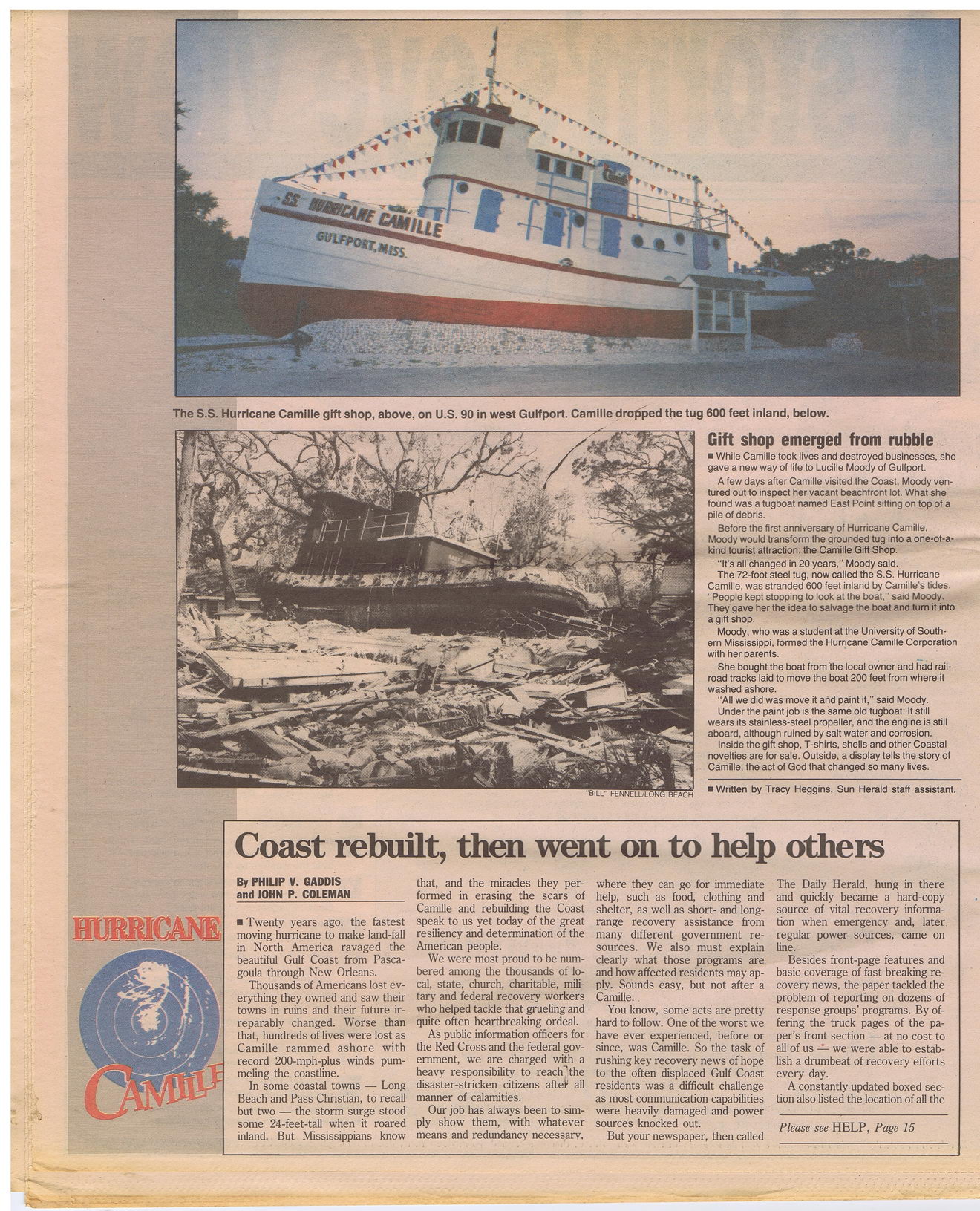This text was obtained via automated optical character recognition.
It has not been edited and may therefore contain several errors.
The S.S. Hurricane Camille gift shop, above, on U.S. 90 in west Gulfport. Camille dropped the tug 600 feet inland, below. BILL” FENNELL/LONG BEACH Gift shop emerged from rubble ■ While Camille took lives and destroyed businesses, she gave a new way of life to Lucille Moody of Gulfport. A few days after Camille visited the Coast, Moody ventured out to inspect her vacant beachfront lot. What she found was a tugboat named East Point sitting on top of a pile of debris. Before the first anniversary of Hurricane Camille, Moody would transform the grounded tug into a one-of-a-kind tourist attraction: the Camille Gift Shop. “It’s all changed in 20 years,” Moody said. The 72-foot steel tug, now called the S.S. Hurricane Camille, was stranded 600 feet inland by Camille’s tides. “People kept stopping to look at the boat,” said Moody. They gave her the idea to salvage the boat and turn it into a gift shop. Moody, who was a student at the University of Southern Mississippi, formed the Hurricane Camille Corporation with her parents. She bought the boat from the local owner and had railroad tracks laid to move the boat 200 feet from where it washed ashore. “All we did was move it and paint it,” said Moody. Under the paint job is the same old tugboat: It still wears its stainless-steel propeller, and the engine is still aboard, although ruined by salt water and corrosion. Inside the gift shop, T-shirts, shells and other Coastal novelties are for sale. Outside, a display tells the story of Camille, the act of God that changed so many lives. ■ Written by Tracy Heggins, Sun Herald staff assistant. Coast rebuilt, then went on to help others By PHILIP V. GADDIS and JOHN P. COLEMAN ■ Twenty years ago, the fastest moving hurricane to make land-fall in North America ravaged the beautiful Gulf Coast from Pascagoula through New Orleans. Thousands of Americans lost everything they owned and saw their towns in ruins and their future irreparably changed. Worse than that, hundreds of lives were lost as Camille rammed ashore with record 200-mph-plus winds pum-meling the coastline. In some coastal towns — Long Beach and Pass Christian, to recall but two — the storm surge stood some 24-feet-tall when it roared inland. But Mississippians know that, and the miracles they performed in erasing the scars of Camille and rebuilding the Coast speak to us yet today of the great resiliency and determination of the American people. We were most proud to be numbered among the thousands of local, state, church, charitable, military and federal recovery workers who helped tackle that grueling and quite often heartbreaking ordeal. As public information officers for the Red Cross and the federal government, we are charged with a heavy responsibility to reach" the disaster-stricken citizens aftet all manner of calamities. Our job has always been to simply show them, with whatever means and redundancy necessary, where they can go for immediate help, such as food, clothing and shelter, as well as short- and long-range recovery assistance from many different government resources. We also must explain clearly what those programs are and how affected residents may apply. Sounds easy, but not after a Camille. You know, some acts are pretty hard to follow. One of the worst we have ever experienced, before or since, was Camille. So the task of rushing key recovery news of hope to the often displaced Gulf Coast residents was a difficult challenge as most communication capabilities were heavily damaged and power sources knocked out. But your newspaper, then called The Daily Herald, hung in there and quickly became a hard-copy source of vital recovery information when emergency and, later, regular power sources, came on line. Besides front-page features and basic coverage of fast breaking recovery news, the paper tackled the problem of reporting on dozens of response groups’ programs. By offering the truck pages of the paper’s front section — at no cost to all of us — we were able to establish a drumbeat of recovery efforts every day. A constantly updated boxed section also listed the location of all the Please see HELP, Page 15

Hurricane Camille Camille-20-Years-Later (16)